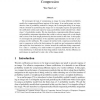Free Online Productivity Tools
i2Speak
i2Symbol
i2OCR
iTex2Img
iWeb2Print
iWeb2Shot
i2Type
iPdf2Split
iPdf2Merge
i2Bopomofo
i2Arabic
i2Style
i2Image
i2PDF
iLatex2Rtf
Sci2ools
DCC
2000
IEEE
2000
IEEE
Trees, Windows, and Tiles for Wavelet Image Compression
We investigate the task of compressing an image by using different probability models for compressing different regions of the image. In an earlier paper, we introduced a class of probability models for images, the k-rectangular tiling of an image, which is formed by partitioning the image into k rectangular regions and generating the coefficients within each region by using a probability model selected from a finite class C of probability models. We also described a computationally efficient sequential probability assignment algorithm that is able to code an image with a code length that is close to the code length produced by the best model in the class. In this paper, we investigate the performance of the algorithm experimentally on the task of compressing wavelet subbands. We compare the method with compression methods that aim to compress as well as the best pruning of a quad-tree and compression methods that exploit the local statistics in a window around the coefficient bei...
Code Length | Computer Graphics | DCC 2000 | Probability Assignment Algorithm | Probability Models |
| Added | 30 Jul 2010 |
| Updated | 30 Jul 2010 |
| Type | Conference |
| Year | 2000 |
| Where | DCC |
| Authors | Wee Sun Lee |
Comments (0)

